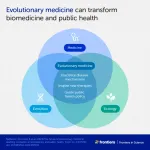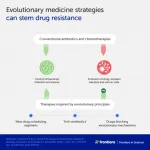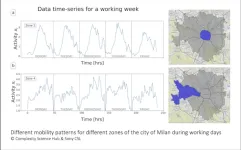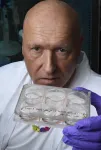(Press-News.org) The word ‘evolution’ may bring to mind dusty dinosaur bones, but it impacts our health every day. For example, even though antibiotics were invented only a century ago, the evolution of antibiotic resistance is already a major concern. The rise in modern health problems such as obesity can also be traced back to evolutionary principles.
An article published in Frontiers in Science demonstrates how applying an evolutionary perspective to medicine can inspire new ways of preventing and treating disease.
“Evolutionary medicine holds promise to transform our understanding of why we get sick and strengthen our ability to protect human health,” said Dr Barbara Natterson-Horowitz, a cardiologist and evolutionary biologist on the faculty of Harvard University and the University of California, Los Angeles. “We came together with experts across many fields to create an overarching research agenda for extending the field.”
“Our aim is to drive new biomedical innovations and effective public health measures, for everything from infectious disease and pandemics to cancer, diabetes, and cardiovascular disease,” said Prof Daniel Blumstein of the University of California, Los Angeles.
Overcoming chemotherapy and antibiotic resistance
Drug resistance is a global health threat in urgent need of solutions. Since bacteria and cancer cells naturally adapt to survive medications, new drug-resistant variants emerge constantly. This problem is currently addressed by continuously producing new antibiotics and cancer chemotherapies – a temporary and costly solution.
Evolutionary-inspired strategies could break this cycle. For example, ‘anti-evolution’ drugs could stop bacteria from sharing resistance genes with each other. ‘Anti-antibiotics’ are another innovative strategy that could stave off many hospital-acquired antibiotic-resistant infections. These infections often occur when antibiotics administered to the bloodstream reach harmless bacteria in the gut, causing antibiotic-resistant strains to evolve and spread. Oral anti-antibiotics that block these drugs in the gut could prevent this.
In the case of cancer, a branch of evolution called extinction biology could help tackle chemotherapy resistance. “The idea is that an effective way to eradicate a population is to first critically reduce its size with an ecological catastrophe – like the meteor strike for the dinosaurs,” explained Blumstein. “And then kill remaining individuals with a second disaster – like the famine that followed the meteor.”
Extinction therapy translates these principles into a clinical strategy. Patients would receive a high dose of one cancer drug to reduce the tumor size, as in current protocols. But before drug resistance has a chance to arise, the first treatment would be replaced by another to kill off the remaining cancer cells.
Using biodiversity to drive biomedical innovation
The authors highlight that many new therapeutic strategies may be hidden in plain sight, among the biodiversity of the natural world.
“Giraffes have the highest blood pressure of any animal, and yet they don’t suffer from the organ damage that hypertension causes in people. And elephants and Tasmanian devils rarely get cancer,” said Natterson-Horowitz. “What is the biology that protects these animals from diseases that kill us? Extraordinarily powerful insights are out there that we haven’t tapped into yet.”
The authors call for a systematic mapping of disease vulnerability and resistance mechanisms in nature: “Creating this database could, within a decade, help identify unique traits and ultimately lead to novel clinical treatments,” said Blumstein.
Improving public health measures
Evolutionary principles could also guide more effective public health policies. “Our bodies and minds evolved in one environment but are living in another – and that causes disease,” said Natterson-Horowitz. “Cardiovascular disease, low fertility, and other common ‘modern’ conditions all result from this evolutionary mismatch.”
These conditions are often treated as ‘lifestyle’ diseases with interventions that place the responsibility fully on the individual, such as exercise and dietary changes. However, this approach of changing health behaviors doesn’t always work. The authors argue that evolutionary-based public health policies would focus on improving ecological conditions instead.
“It’s not about treating diabetes when a person gets it at 40, but about making the investment during childhood. Policies that promote interventions early in life can have an immensely positive effect on future health and welfare,” Blumstein added.
An evolutionary-inspired roadmap for better health
Evolutionary perspectives are already making their way into the public and political agenda. Some countries have restricted antibiotics use and introduced taxes on sugar-sweetened beverages. However, the authors emphasize that realizing the full potential of evolutionary medicine requires greater investment and interdisciplinary collaboration.
“Evolutionary insights have tremendous – and as yet unrealized – potential to better understand, prevent, and treat existing and emerging threats to human, animal, and planetary health. Our article provides a roadmap for basic biological and biomedical research as well as the development of innovative biomedicines and more effective public health measures,” the authors concluded.
END
From anti-antibiotics to extinction therapy: how evolutionary thinking can transform medicine
An article published in Frontiers in Science demonstrates how applying an evolutionary perspective to medicine can inspire new ways of preventing and treating disease
2023-02-28
ELSE PRESS RELEASES FROM THIS DATE:
Researchers from the Institute of Botany discovered a new type of coexistence between algae and fungi
2023-02-28
Researchers from the Institute of Botany, Czech Academy of Sciences, described the symbiotic relationship between fungi and algae which science has largely overlooked until now. The coexistence of algae and corticioid basidiomycetes, which are common in temperate forests, has been given a new name: alcobiosis.
Jan Vondrák of the Department of Taxonomy, Institute of Botany, and the first author of the study says “Years ago, during field trips, we were repeatedly puzzled to find a layer of green algae where some of the fungal coatings on wood or bark (so-called corticioid fungi) are disturbed. We discovered that this is a ...
The largest genomic study of rare cancer metastathic pheochromocytoma identifies patients at highest risk of metastasis and those who would respond to immunotherapy
2023-02-28
The new results will help to follow patients with a bad prognosis more closely, and to move towards more personalized treatments.
Mercedes Robledo, co-lead author, has been studying pheochromocytomas since 1996 and leads the CNIO group that has identified 5 of the 22 genes associated with these rare tumors.
The research analyzes an "exceptionally high" number of samples, something very difficult in rare diseases and achieved thanks to the collaboration of centers from countries all over the world.
Pheochromocytoma is a rare tumor, with an ...
How to predict city traffic
2023-02-28
A new machine learning model can predict traffic activity in different zones of cities. To do so, a Complexity Science Hub researcher used data from a main car-sharing company in Italy as a proxy for overall city traffic. Understanding how different urban zones interact can help avoid traffic jams, for example, and enable targeted responses of policy makers - such as local expansion of public transportation.
Understanding people's mobility patterns will be central to improving urban traffic flow. “As populations grow in urban areas, this knowledge can help policymakers design and implement effective transportation ...
Parental support for LGBTQ youth is important, research shows
2023-02-28
Depression is more widespread among lesbian, gay, bisexual, transgender, or questioning (LGBTQ) youth than heterosexual, cisgender youth, making parental support more important for these adolescents. A new study released in Child Development by researchers at The University of Texas at Austin looks at parental social support and psychological control in relation to depressive symptoms for LGBTQ youth in the United States. Psychological control attempts to intrude into the psychological and emotional development of the child (e.g., thinking processes, self-expression, emotions, and attachment to parents). Although ...
SUTD to launch south-east Asia’s first O-RAN Open Testing and Integration Centre (OTIC)
2023-02-28
SUTD to Launch South-east Asia’s First O-RAN Open Testing and Integration Centre (OTIC)
Announced at the Mobile World Congress Barcelona (MWC) 2023, Singapore University of Technology and Design (SUTD) will launch a new O-RAN[1] Asia & Pacific Open Testing and Integration Centre (OTIC) in Singapore. As part of Singapore’s S$70 million Future Communications R&D Programme (FCP) supported by Singapore’s Infocomm Media Development Authority (IMDA) and the National Research Foundation, Singapore (NRF), the Asia & Pacific OTIC in Singapore ...
12 exotic bacteria found to passively collect rare earth elements from wastewater
2023-02-28
Rare earth elements (REEs) are a group of 17 chemically similar metals, which got their name because they typically occur at low concentrations (between 0.5 and 67 parts per million) within the Earth’s crust. Because they are indispensable in modern technology such as light emitting diodes, mobile phones, electromotors, wind turbines, hard disks, cameras, magnets, and low-energy lightbulbs, the demand for them has increased steadily over the past few decades, and is predicted to rise further by 2030.
As ...
Will future computers run on human brain cells?
2023-02-28
A “biocomputer” powered by human brain cells could be developed within our lifetime, according to Johns Hopkins University researchers who expect such technology to exponentially expand the capabilities of modern computing and create novel fields of study.
The team outlines their plan for “organoid intelligence” today in the journal Frontiers in Science.
“Computing and artificial intelligence have been driving the technology revolution but they are reaching a ceiling,” said Thomas Hartung, a professor of environmental health sciences at ...
Study reveals improvements in workplace support and leadership training will improve the mental health and potentially reduce burnout in healthcare professionals
2023-02-28
Amongst healthcare professionals, the feeling of being supported in the workplace can protect them against adverse mental health and burnout, according to a new study published in CMAJ Open by researchers at Queen Mary University of London and medical staff at various hospitals across the UK.
CoPE-HCP study was designed, during the early part of COVID-19 pandemic, when there was great concern for the mental health of healthcare professionals with no scientifically-proven mitigating strategies to reduce that impact. Funded by Barts Charity, this new longitudinal study found that feeling unsupported ...
Immune system drug shows promise in treating alcohol use disorder, a Scripps Research clinical trial reports
2023-02-28
LA JOLLA, CA—A clinical trial carried out at Scripps Research has shown that apremilast, approved by the U.S. Food and Drug Administration (FDA) for the treatment of psoriasis, cuts alcohol intake by more than half in people with severe alcohol use disorder (AUD). Collaborators at Oregon Health and Science University (OHSU) and other institutions also showed that, in mice, apremilast boosts activity in an area of the brain known to be involved in AUD.
The research was published online ahead of ...
$10 million grant funds Scripps Research Alcohol Research Center through its 50th year
2023-02-28
LA JOLLA, CA—The National Institute on Alcohol Abuse and Alcoholism (NIAAA) has awarded scientists at Scripps Research a $10 million grant to study the cellular and molecular changes in the brain that underlie alcohol use disorder (AUD). The grant will fund the Scripps Research Alcohol Research Center (TSRI-ARC) for five years, carrying the research into its 50th year of consecutive NIAAA funding—first beginning in 1977.
“A lot of exciting things have happened in the AUD field over the last 45 years, and the center has been at the forefront of many of them,” ...
LAST 30 PRESS RELEASES:
Making lighter work of calculating fluid and heat flow
Normalizing blood sugar can halve heart attack risk
Lowering blood sugar cuts heart attack risk in people with prediabetes
Study links genetic variants to risk of blinding eye disease in premature infants
Non-opioid ‘pain sponge’ therapy halts cartilage degeneration and relieves chronic pain
AI can pick up cultural values by mimicking how kids learn
China’s ecological redlines offer fast track to 30 x 30 global conservation goal
Invisible indoor threats: emerging household contaminants and their growing risks to human health
Adding antibody treatment to chemo boosts outcomes for children with rare cancer
Germline pathogenic variants among women without a history of breast cancer
Tanning beds triple melanoma risk, potentially causing broad DNA damage
Unique bond identified as key to viral infection speed
Indoor tanning makes youthful skin much older on a genetic level
Mouse model sheds new light on the causes and potential solutions to human GI problems linked to muscular dystrophy
The Journal of Nuclear Medicine ahead-of-print tip sheet: December 12, 2025
Smarter tools for peering into the microscopic world
Applications open for funding to conduct research in the Kinsey Institute archives
Global measure underestimates the severity of food insecurity
Child survivors of critical illness are missing out on timely follow up care
Risk-based vs annual breast cancer screening / the WISDOM randomized clinical trial
University of Toronto launches Electric Vehicle Innovation Ontario to accelerate advanced EV technologies and build Canada’s innovation advantage
Early relapse predicts poor outcomes in aggressive blood cancer
American College of Lifestyle Medicine applauds two CMS models aligned with lifestyle medicine practice and reimbursement
Clinical trial finds cannabis use not a barrier to quitting nicotine vaping
Supplemental nutrition assistance program policies and food insecurity
Switching immune cells to “night mode” could limit damage after a heart attack, study suggests
URI-based Global RIghts Project report spotlights continued troubling trends in worldwide inhumane treatment
Neutrophils are less aggressive at night, explaining why nighttime heart attacks cause less damage than daytime events
Menopausal hormone therapy may not pose breast cancer risk for women with BRCA mutations
Mobile health tool may improve quality of life for adolescent and young adult breast cancer survivors
[Press-News.org] From anti-antibiotics to extinction therapy: how evolutionary thinking can transform medicineAn article published in Frontiers in Science demonstrates how applying an evolutionary perspective to medicine can inspire new ways of preventing and treating disease






